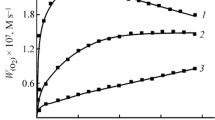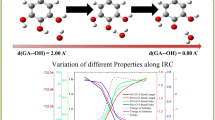Abstract
When measuring antioxidant activities in micelles and emulsions, the location of the antioxidant or of the probe has long been recognized as an important issue. The present chapter represents one step further in these studies, by drawing attention to the importance of the proximity between the interacting centers of a probe/antioxidant pair, even when the two species are located in the same or in similar environments. The use of 4-alkanoyloxy-1,1,6,6-tetramethylpyperidineoxyl (TEMPO) radicals as probes for AOs in micellar systems or emulsions, reveals cut-off patterns that suggest a novel interpretation of the polar paradox, based on the orientation of the probe and/or AO in these systems. Changes in orientation in a micro-heterogeneous medium are associated with structural features of these molecules, and with their amphiphobic character. These molecules are characterized by possessing two end-groups of variable lipophilicity. In a heterogeneous interface, a competition is established between these groups for the hydrophobic core of a micelle or emulsion droplet, leading to distinct orientations and degrees of insertion into the lipophilic core. The whole process is adequately described by a schematic depiction, the “diving-swan” analogy. Examples from the literature of this process and of cut-off patterns of behavior for various AOs in micro-heterogeneous systems are presented and discussed. They give support to this approach, originally developed from observations with the behavior of the 4-substituted TEMPO derivatives as probes in these systems. As the polar paradox is a rather general phenomenon, encountered not only in the assessment of antioxidant activities in food extracts but also in a larger variety of biological systems, the present approach can find interesting applications in the future, in the analysis of this paradox in biological systems.
Access this chapter
Tax calculation will be finalised at checkout
Purchases are for personal use only
Similar content being viewed by others
References
Ahmadi F, Kadivar M, Shahedi M (2007) Antioxidant activity of Kelussia odoratissima Mozaff. In model and food systems. Food Chem 105(1):57–64
Aliaga C, Rezende MC, Arenas A (2009a) How meaningful is the assessment of antioxidant activities in microheterogeneous media? Food Chem [Internet] 113(4):1083–1087
Aliaga C, Rezende MC, Arenas A (2009b) How meaningful is the assessment of antioxidant activities in microheterogeneous media? Food Chem 113(4):1083–1087
Aliaga C, Torres P, Silva F (2012) A simple method for the determination of the partitioning of nitroxide probes in microheterogeneous media. Magn Reson Chem 50(12):779–783
Aliaga C, Bravo-Moraga F, Gonzalez-Nilo D, Márquez S, Lühr S, Mena G et al (2016a) Location of TEMPO derivatives in micelles: subtle effect of the probe orientation. Food Chem 192:395–401
Aliaga C, Rezende C, Mena G (2016b) The effect of micellization on the EPR spectra tetramethylpiperidinoxyl (TEMPO) radicals. Magn Reson Chem 54(11):870–873
Aliaga C, Lopez de Arbina A, Rezende MC (2016c) “Cut-off” effect of antioxidants and/or probes of variable lipophilicity in microheterogeneous media. Food Chem 206:119–123
Aliaga C, López de Arbina A, Pastenes C, Rezende MC (2018) Antioxidant-spotting in micelles and emulsions. Food Chem 245:240–245
Almajano MP, Carbó R, Jiménez JAL, Gordon MH (2008) Antioxidant and antimicrobial activities of tea infusions. Food Chem 108(1):55–63
Aspée A, Aliaga C, Maretti L, Zúñiga-Núñez D, Godoy J, Pino E et al (2017) Reaction kinetics of phenolic antioxidants toward Photoinduced Pyranine free radicals in biological models. J Phys Chem B 121(26):6331–6340
Balgavý P, Devínsky F (1996) Cut-off effects in biological activities of surfactants. Adv Colloid Interf Sci 66:23–63
Boroski M, Aguiar AC, Rotta EM, Bonafe EG, Valderrama P, Souza NE et al (2018) Antioxidant activity of herbs and extracted phenolics from oregano in canola oil. Int Food Res J 25(6):2444–2452
Costa M, Losada-Barreiro S, Paiva-Martins F, Bravo-Díaz C (2017) Physical evidence that the variations in the efficiency of homologous series of antioxidants in emulsions are a result of differences in their distribution. J Sci Food Agric 97(2):564–571
Costa M, Losada-Barreiro S, Bravo-Díaz C, Vicente AA, Monteiro LS, Paiva-Martins F (2020) Influence of AO chain length, droplet size and oil to water ratio on the distribution and on the activity of gallates in fish oil-in-water emulsified systems: emulsion and nanoemulsion comparison. Food Chem 310:125716–125723
Cui L, Mcclements DJ, Decker EA (2015) Impact of phosphatidylethanolamine on the antioxidant activity of α-tocopherol and trolox in bulk oil. J Agric Food Chem 63(12):3288–3294
Dar AA, Bravo-Diaz C, Nazir N, Romsted LS (2017) Chemical kinetic and chemical trapping methods: unique approaches for determining respectively the antioxidant distributions and interfacial molarities of water, counter-anions, and other weakly basic nucleophiles in association colloids. Curr Opin Colloid Int Sci 32:84–93
Durand E, Zhao Y, Ruesgas-Ramón M, Figueroa-Espinoza MC, Lamy S, Coupland JN et al (2019) Evaluation of antioxidant activity and interaction with radical species using the vesicle conjugated Autoxidizable Triene (VesiCAT) assay. Eur J Lipid Sci Technol 121(5):1–8
Fabris S, Momo F, Ravagnan G, Stevanato R (2008) Antioxidant properties of resveratrol and piceid on lipid peroxidation in micelles and monolamellar liposomes. Biophys Chem 135(1–3):76–83
Ferreira I, Costa M, Losada-Barreiro S, Paiva-Martins F, Bravo-Díaz C (2018) Modulating the interfacial concentration of gallates to improve the oxidative stability of fish oil-in-water emulsions. Food Res Int 112:192–198
Freiría-Gándara J, Losada-Barreiro S, Paiva-Martins F, Bravo-Díaz C (2018) Enhancement of the antioxidant efficiency of gallic acid derivatives in intact fish oil-in-water emulsions through optimization of their interfacial concentrations. Food Funct 9(8):4429–4442
González MJ, Medina I, Maldonado OS, Lucas R, Morales JC (2015) Antioxidant activity of alkyl gallates and glycosyl alkyl gallates in fish oil in water emulsions: relevance of their surface active properties and of the type of emulsifier. Food Chem 183:190–196
Keller S, Locquet N, Cuvelier ME (2016) Partitioning of vanillic acid in oil-in-water emulsions: impact of the tween®40 emulsifier. Food Res Int 88:61–69
Krudopp H, Sönnichsen FD, Steffen-Heins A (2015) Partitioning of nitroxides in dispersed systems investigated by ultrafiltration, EPR and NMR spectroscopy. J Colloid Interface Sci 452:15–23
Kumar A, Chauhan PK, Bhardwaj VS, Kumar R, Tyagi A (2011) In vitro antioxidant & phytochemical investigations of ethanolic extracts of viola serpens & morus nigrav. J Chem Pharm Res 3(4):166–171
Kusumahastuti DKA, Sihtmäe M, Kapitanov IV, Karpichev Y, Gathergood N, Kahru A (2019) Toxicity profiling of 24 L-phenylalanine derived ionic liquids based on pyridinium, imidazolium and cholinium cations and varying alkyl chains using rapid screening Vibrio fischeri bioassay. Ecotoxicol Environ Saf 172:556–565
Laguerre M, López Giraldo LJ, Lecomte J, Figueroa-Espinoza M-C, Baréa B, Weiss J et al (2009) Chain length affects antioxidant properties of Chlorogenate esters in emulsion: the cutoff theory behind the polar paradox. J Agric Food Chem 57(23):11335–11342
Lopez de Arbina A, Losada-Barreiro S, Rezende MC, Vidal M, Aliaga C (2019) The location of amphiphobic antioxidants in micellar systems: the diving-swan analogy. Food Chem 279:288–293
López-Alarcón C, Aspée A, Henríquez C, Campos AM, Lissi EA (2005) Interaction and reactivity of urocanic acid towards peroxyl radicals. Redox Rep 10(4):227–234
Losada-Barreiro S, Sova M, Mravljak J, Saso L, Bravo-Díaz C (2020) Synthesis, in vitro antioxidant properties and distribution of a new cyanothiophene-based phenolic compound in olive oil-in-water emulsions. Antioxidants 9(7):1–16
Lue BM, Sørensen ADM, Jacobsen C, Guo Z, Xu X (2017) Antioxidant efficacies of rutin and rutin esters in bulk oil and oil-in-water emulsion. Eur J Lipid Sci Technol 119(4):1–15
Martinović N, Poklar Ulrih N, Abramovič H (2019) Sinapic acid and its derivatives increase oxidative stability in different model lipid systems. Eur J Lipid Sci Technol 121(4):1–10
Mateos R, Madrona A, Pereira-Caro G, Domínguez V, Cert RM, Parrado J et al (2015) Synthesis and antioxidant evaluation of isochroman-derivatives of hydroxytyrosol: structure-activity relationship. Food Chem 173:313–320
Meireles M, Losada-Barreiro S, Costa M, Paiva-Martins F, Bravo-Díaz C, Monteiro LS (2019) Control of antioxidant efficiency of chlorogenates in emulsions: modulation of antioxidant interfacial concentrations. J Sci Food Agric 99(8):3917–3925
Montoro P, Braca A, Pizza C, De Tommasi N (2005) Structure-antioxidant activity relationships of flavonoids isolated from different plant species. Food Chem 92(2):349–355
Mukai K, Ishikawa E, Ouchi A, Nagaoka S-I, Abe K, Suzuki T et al (2018 Jun 1) Measurements of singlet oxygen-quenching activity of vitamin E homologs and palm oil and soybean extracts in a micellar solution. Lipids 53(6):601–613
Nogueira CCR, Paixão ICNDP, Teixeira VL (2014) Antioxidant activity of natural products isolated from red seaweeds. Nat Prod Commun 9(7):1031–1036
Noon J, Mills TB, Norton IT. The use of natural antioxidants to combat lipid oxidation in O/W emulsions. Journal of Food Engineering [Internet]. 2020; 281:110006–19. Available from: https://doi.org/10.1016/j.jfoodeng.2020.110006
Özcan MM, Al Juhaimi F, Ahmed IAM, Uslu N, Babiker EE, Ghafoor K (2020) Effect of microwave and oven drying processes on antioxidant activity, total phenol and phenolic compounds of kiwi and Pepino fruits. J Food Sci Technol 57(1):233–242
Parmar A, Singh K, Bahadur A, Marangoni G, Bahadur P (2011) Interaction and solubilization of some phenolic antioxidants in Pluronic® micelles. Colloids Surf B: Biointerfaces 86(2):319–326
Porter WL (1993) Paradoxical behavior of antioxidants in food and biological systems. Toxicol Ind Health 9(1–2):93–122
Porter WL, Black ED, Drolet AM (1989) Use of polyamide oxidative fluorescence test on lipid emulsions: contrast in relative effectiveness of antioxidants in bulk versus dispersed systems. J Agric Food Chem 37(3):615–624
Raimúndez-Rodríguez EA, Losada-Barreiro S, Bravo-Díaz C (2019) Enhancing the fraction of antioxidants at the interfaces of oil-in-water emulsions: a kinetic and thermodynamic analysis of their partitioning. J Colloid Interface Sci 555:224–233
Romsted LS, Zhang J (2004) Determining antioxidant distributions in model food emulsions: development of a new kinetic method based on the pseudophase model in micelles and opaque emulsions. Progr Colloid Polym Sci 123:182–187
Shahidi F, Zhong Y (2011) Revisiting the polar paradox theory: a critical overview. J Agric Food Chem 59(8):3499–3504
Shao Y, Du Z, Zhang C, Zhu L, Wang J, Wang J (2017) Acute toxicity of imidazole nitrate ionic liquids with varying chain lengths to earthworms (Eisenia foetida). Bull Environ Contam Toxicol 99(2):213–217
Shao Y, Wang J, Du Z, Li B, Zhu L, Wang J (2018) Toxicity of 1-alkyl-3-methyl imidazolium nitrate ionic liquids to earthworms: the effects of carbon chains of different lengths. Chemosphere 206:302–309
Shao Y, Wang J, Wang J, Du Z, Li B, Zhu L et al (2019) Oxidative stress and genotoxic effects in earthworms induced by five imidazolium bromide ionic liquids with different alkyl chains. Chemosphere 227:570–579
Teixeira S, Siquet C, Alves C, Boal I, Marques MP, Borges F et al (2005) Structure-property studies on the antioxidant activity of flavonoids present in diet. Free Radic Biol Med 39(8):1099–1108
Thippeswamy TG, Vidyashree HK, Hemavathi, Kengaiah J (2020) Antioxidant activity in methanolic extract of selected vegetables. Int J Pharm Pharm 17(2):151–160
Wang YL, Wu C, Zhou XY, Zhang MR, Chen Y, Nie SP et al (2020) Combined application of gallate ester and α-tocopherol in oil-in-water emulsion: their distribution and antioxidant efficiency. J Dispers Sci Technol 41(6):909–917
Ye L, Pham-Mondala A, Li J, Joseph P, Nahas R, Michel-Salaun F (2019) Using confocal microscopy to estimate the distribution of natural antioxidants in poultry meal and extruded kibbles. Eur J Lipid Sci Technol 121(9):1–7
Yeşilyurt V, Halfon B, Öztürk M, Topçu G (2008) Antioxidant potential and phenolic constituents of Salvia cedronella. Food Chem 108(1):31–39
Zapata-Morin PA, Sierra-Valdez FJ, Ruiz-Suárez JC (2020) The cut-off effect of n-alcohols in lipid rafts: a lipid-dependent phenomenon. J Mol Graph Model 101:1–7
Acknowledgements
Thanks are given to FONDECYT 1200192 project and Basal financing AFB180001 (CEDENNA). Special thanks to our student Mg. Amaia López de Arbina and Ms. Camila Pastenes for their helpful and devoted labwork done.
Author information
Authors and Affiliations
Corresponding author
Editor information
Editors and Affiliations
Rights and permissions
Copyright information
© 2022 The Author(s), under exclusive license to Springer Nature Switzerland AG
About this chapter
Cite this chapter
Aliaga, C., Rezende, M.C. (2022). Location, Orientation and Buoyance Effects of Radical Probes as Studied by EPR. In: Bravo-Diaz, C. (eds) Lipid Oxidation in Food and Biological Systems. Springer, Cham. https://doi.org/10.1007/978-3-030-87222-9_6
Download citation
DOI: https://doi.org/10.1007/978-3-030-87222-9_6
Published:
Publisher Name: Springer, Cham
Print ISBN: 978-3-030-87221-2
Online ISBN: 978-3-030-87222-9
eBook Packages: Chemistry and Materials ScienceChemistry and Material Science (R0)




